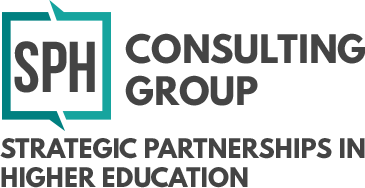“What’s in it for me?” Maximizing stakeholder engagement during a merger
January 6, 2023

Higher education is a service and institutions of higher education are wise to consider themselves service providers. Most do not frame academia in this way, but just as an auto repair shop fixes a car or a health care provider gets a patient back on his feet, colleges and universities serve students through teaching, research and community service. In services, we know consumers are risk-averse. It is simple human nature. People want to find a way to engage with a service provider to have their expectations met and to do so with limited interruption or friction. A merger or consolidation in higher education could easily be a source of friction or discomfort to consumers including students, faculty, staff, alumni, and communities served. So how do we approach our stakeholder engagement to minimize the risks and prepare our communities for change? At SPH Consulting Group, we consider the following when preparing our clients for success.
Determining your audiences.
When colleges or universities make the decision to merge or consolidate, there are numerous parties with a vested interest in the outcome of such a decision: alumni, current and prospective students, donors, faculty, staff, affiliates, regional accreditors, state office of education, and many more. Consider all who may be impacted or have even a peripheral interest in what is happening, including peers. And especially if you are a state-funded institution, you must ensure state and local officials are also included.
Segmenting your audiences.
As with any organizational change, providing context is key. Everyone will want to know the answer to the question, “What is in it for me?” The answer to this question will differ for each audience. However, it is key to segment your audiences, to communicate the right message, at the right time, and to the right people.
Creating a systematic approach for all voices to be heard – and promptly answered.
Often times in academia, we find the noisiest constituencies or the loudest voices are often responded to first. This leads to disengagement from other key stakeholders who don’t know how or when to voice their opinions. Or simply are trying to voice their thoughts in a quieter, calmer, more less confrontational manner. To prevent disengagement or lopsided feedback, administrations should take a proactive approach and a priori determine primary and secondary audiences. Then allow individuals to express themselves in a documented fashion, whether through an online survey or multiple town halls. Consider the timing of events to ensure audience availability and participation. Ensure the questions you are asking are related to the segment of the audience you are addressing. And consider the following – Do they have enough information to answer the questions? How will their feedback influence future decisions?
As with any organization in the service industry, if institutions put PEOPLE FIRST in their stakeholder engagement planning, the outcome will be sustainable and will create loyalty to the institution’s brand, post-merger.
Writer: Aubrey Hinkson, Consultant, SPH Consulting Group
To learn more about SPH Consulting Group and how we can help your organization, contact office@sphconsultinggroup.com.
